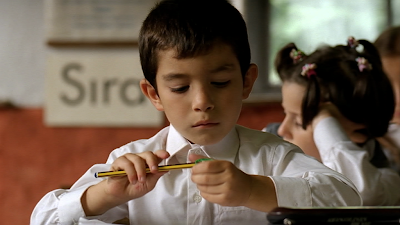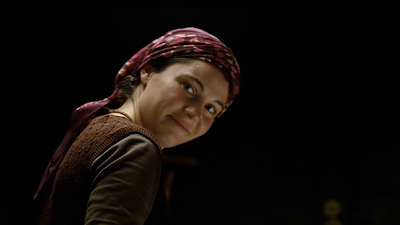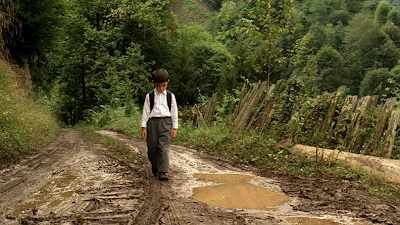 Bal (Honey)
Bal (Honey)A film by Semih Kaplanoglu
Country:Turkey
Year 2010
Runtime: 103 minutes
Turkish with English subtitles
7th August 2011; 5.45pm
Perks Mini Theater
Perks School
 Turkish filmmaker Semih Kaplanoglu’s Bal (Honey) fall under the spell of this contemplative drama about a boy (Altas) and his dad (Besikçioglu), a rural beekeeper. Bal walks a fine line between affecting, character-based drama and long-take academicism, nearly always coming down on the side of the former thanks to the film's close alignment with the viewpoint of its preteen protagonist.
Turkish filmmaker Semih Kaplanoglu’s Bal (Honey) fall under the spell of this contemplative drama about a boy (Altas) and his dad (Besikçioglu), a rural beekeeper. Bal walks a fine line between affecting, character-based drama and long-take academicism, nearly always coming down on the side of the former thanks to the film's close alignment with the viewpoint of its preteen protagonist. The plot of Bal (Honey) is simple and incidental: the straightforward story of a young boy’s all encompassing love for his father and his weariness of everyone else.
The plot of Bal (Honey) is simple and incidental: the straightforward story of a young boy’s all encompassing love for his father and his weariness of everyone else. Set in the impossibly lush mountains along the Black Sea coast of northeast Turkey, it could have been a nature film, made only to capture the stunning mist-bathed surroundings. But perhaps it’s a tribute to Yusuf (Bora Altas), the seven-year-old protagonist with the unnerving presence of a pensive cub.
Set in the impossibly lush mountains along the Black Sea coast of northeast Turkey, it could have been a nature film, made only to capture the stunning mist-bathed surroundings. But perhaps it’s a tribute to Yusuf (Bora Altas), the seven-year-old protagonist with the unnerving presence of a pensive cub. Yusuf doesn’t utter a word to his mother (Tulin Ozen), stutters when called upon in class, and regards everything around him with bemused silence. But his father (Erdal Besikcioglu)—a beekeeper who plants his hives high up in the soaring trees—wisely cajoles the boy to speak in whispers, and he responds in the same hushed tones.
Yusuf doesn’t utter a word to his mother (Tulin Ozen), stutters when called upon in class, and regards everything around him with bemused silence. But his father (Erdal Besikcioglu)—a beekeeper who plants his hives high up in the soaring trees—wisely cajoles the boy to speak in whispers, and he responds in the same hushed tones. Their relationship pushes the two into a private space within their already isolated landscape. When his father doesn’t return from a trip into the woods, Yusuf and his mother go looking for him. If he isn’t found, Yusuf might lose his only connection to the world.
Their relationship pushes the two into a private space within their already isolated landscape. When his father doesn’t return from a trip into the woods, Yusuf and his mother go looking for him. If he isn’t found, Yusuf might lose his only connection to the world. Bal revels in the beauty and sweetness of children and nature. Bal, which resembles more of a fairytale and feels centuries away from the modern world.
Bal revels in the beauty and sweetness of children and nature. Bal, which resembles more of a fairytale and feels centuries away from the modern world. Perhaps it should be treated like a two-hour meditation for which a patient mood and disposition are absolutely critical. And like a meditation, the effects may only be palpable after the spell is broken and the movie ends.
Perhaps it should be treated like a two-hour meditation for which a patient mood and disposition are absolutely critical. And like a meditation, the effects may only be palpable after the spell is broken and the movie ends.(Source:Internet)

Semih Kaplanoğlu (born 1963 in İzmir, Turkey)is a Turkish playwright, film director and producer. He graduated from the Cinema and Television Section of the Faculty of Fine Arts at the Dokuz Eylül University in his hometown. He became an assistant cameraman for two award-winning documentary films.
Later, Kaplanoğlu wrote the script and directed a television series with 52 episodes, which became successful at the channels Show TV and InterStar. The first film he directed, Herkes Kendi Evinde (Away From Home) won many awards participating at international film festivals. Kaplanoğlu's second feature film Meleğin Düşüşü (Angel's Fall) premiered at the 2006 Berlin International Film Festival and found wide interest by international film critics and audience.
His film Yumurta (Egg) brought many international awards for best film, best director, best screenplay.He founded his own film production company Kaplan Film. Its first feature film Egg was a co-production with Greece. Kaplanoğlu's film Süt (Milk) was released in Germany in January 2010, which with Yumurta (Egg) and the film Bal (Honey) produced in 2010, forms a trilogy called Yusuf Üçlemesi (Yusuf's Trilogy), named after the main character Yusuf of the films.
His 2010 film, Bal won the Golden Bear at the 60th Berlin International Film Festival.
Later, Kaplanoğlu wrote the script and directed a television series with 52 episodes, which became successful at the channels Show TV and InterStar. The first film he directed, Herkes Kendi Evinde (Away From Home) won many awards participating at international film festivals. Kaplanoğlu's second feature film Meleğin Düşüşü (Angel's Fall) premiered at the 2006 Berlin International Film Festival and found wide interest by international film critics and audience.
His film Yumurta (Egg) brought many international awards for best film, best director, best screenplay.He founded his own film production company Kaplan Film. Its first feature film Egg was a co-production with Greece. Kaplanoğlu's film Süt (Milk) was released in Germany in January 2010, which with Yumurta (Egg) and the film Bal (Honey) produced in 2010, forms a trilogy called Yusuf Üçlemesi (Yusuf's Trilogy), named after the main character Yusuf of the films.









